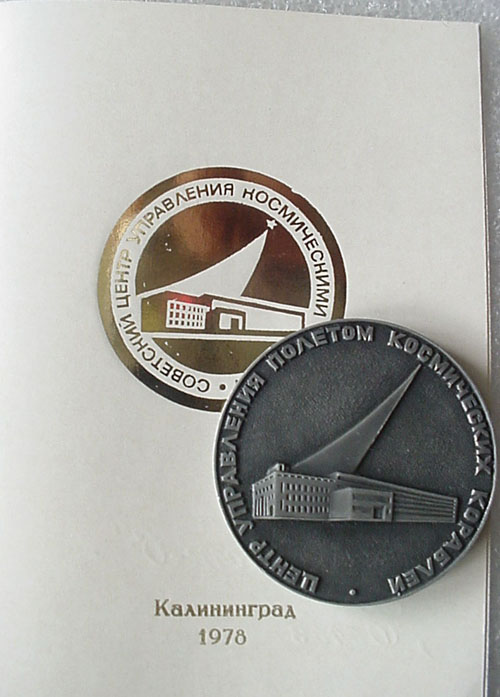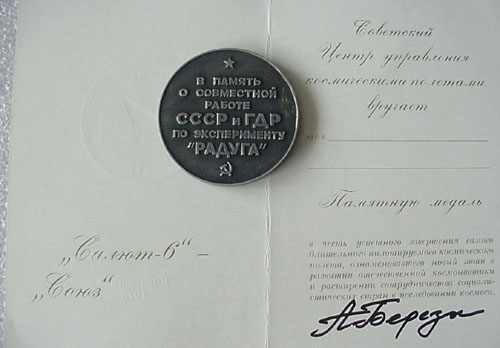60 mm diameter medal minted from metal of flown in cosmos ship was officially issued by Soviet Space Flight Control Center in 1978 for ballistics of Mission Control Center and participants of flight and participants of flight preparation Soyuz-29/Soyuz-31/Salyut-6.Front side of medal depicts early logo of Mission Control Center and reads `Space ships flight control center`.On reverse side reads :In commemoration of joint work USSR-GDR in experiment Raduga` (info on experiment Raduga-Rainbow read below).
Medal from collection of former Vice-Chairman of the USSR Cosmonautics Federation, cosmonaut Anatoliy Berezovoy.Certificate of Mission Control Center signed by him.There is a blank space on certificate in the area where should be placed name of awardee.Front side of certificate shows Spaceflight Control Center emblem in gold and inside reads:Salyut-6-Soyuz. Soviet Space Flight Control Center award with commemorative medal in honor of accomplishing world`s longest space flight- a new era in development of domestic cosmonautics and enlargement of cooperation of socialist countries in exploration of cosmos.
During the flight in 1978 the second Salyut-6 station resident crew Kovalyonok and Ivanchenkov set a new endurance record over 139 days.Soyuz-29 cosmonauts returned to Earth aboard Soyuz-31, which flown to station by commander Valeriy Bikovskiy and first German cosmonaut Sigmund Jaehn to joint Kovalyonok and Ivanchenkov.This Intercosmos team returned to Earth aboard Soyuz-29.
And here are the details on experiment Raduga (Rainbow):Cosmonauts Kovalynok and Ivanchenkov, longtime residents of the Salyut 6-Soyuz 29 orbital complex, eagerly awaited the arrival of Soyuz 31. And, on August 27, 1978, a jubilant Soyuz 31 crew achieved a successful docking. Though the reunion was joyous, the men soon began work on planned research and experiments. These experiments designed by scientists of both the Soviet Union and the German Democratic Republic, covered many areas of scientific interest. The biological experiments studied the effects of spaceflight on the development of bacteria and the culture of tissues. On August 28, the men began the Berolina experiments designed to produce a high quality glass that is especially prized in German factories. This rare glass is very difficult to produce except in conditions of weightlessness. Though these experiments were immensely important, one of the crew`s primary experiments was the Raduga experiment. This shared venture involved exploration of the Earth`s environment and natural resources through photography. The MKF-6M multi-spectral camera was crucial to this project. By photographing vast areas of Earth, the MKF-6M speeds up cartographing of inaccessible regions and provides important weather forecasting information for meteorologists. Indeed, the Intercosmos linkup of Soyuz 31 and the subsequent experiments in space were a scientific victory for the entire world.
Thank you for reading this long description.


This product was added to our catalog on Sunday 13 April, 2003.